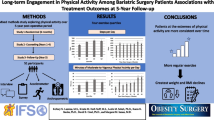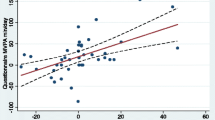Abstract
Background
Most patients do not meet the recommended level of physical activity after bariatric surgery, and psychological factors underlying postoperative physical activity remain poorly understood. This study aimed at identifying self-regulatory predictors of physical activity after bariatric surgery.
Methods
Questionnaire data including self-regulation variables and the short-version of the International Physical Activity Questionnaire were obtained in a prospective cohort of 230 patients 1 year after Roux-en-Y gastric bypass. The study sample consisted of participants consenting to wear an ActiGraph GT3X+ accelerometer for seven consecutive days, 18–24 months after surgery (n = 120).
Results
A total of 112 participants with complete self-report data provided valid accelerometer data. Mean age was 46.8 years (SD = 9.3), and 81.3% was women. Preoperative and postoperative BMI was 44.8 ± 5.5 and 30.6 ± 5.0 kg/m2, respectively. Total weight loss was 28.9% (SD = 7.5). By objective measures, 17.9% of the participants met the recommended level of moderate-to-vigorous-intensity of physical activity of ≥150 min/week, whereas 80.2% met the recommended level according to self-reported measures. Being single, higher education level, and greater self-regulation predicted objective physical activity in multivariate regression analysis. Greater self-regulation also predicted self-reported physical activity. Weight loss 1 year after surgery was not associated with self-reported or objectively measured physical activity.
Conclusions
Despite large differences between accelerometer-based and subjective estimates of physical activity, the associations of self-regulatory factors and weight loss with postoperative physical activity did not vary depending on mode of measurement. Self-regulation predicted both objective and self-reported physical activity. Targeting patients’ self-regulatory ability may enhance physical activity after gastric bypass.
Similar content being viewed by others
References
Coen PM, Goodpaster BH. A role for exercise after bariatric surgery? Diabetes Obes Metab. 2016;18(1):16–23. doi:10.1111/dom.12545.
Mechanick JI, Youdim A, Jones DB, et al. Clinical practice guidelines for the perioperative nutritional, metabolic, and nonsurgical support of the bariatric surgery patient—2013 update: cosponsored by American Association of Clinical Endocrinologists, The Obesity Society, and American Society for Metabolic & Bariatric Surgery. Obesity. 2013;21(S1):S1–S27.
Helsedirektoratet. Anbefalinger om kosthold, ernæring og fysisk aktivitet. In: Helsedirektoratet, editor. Oslo: Andvord Grafisk AS; 2012
O’Donovan G, Blazevich AJ, Boreham C, et al. The ABC of physical activity for health: a consensus statement from the British Association of Sport and Exercise Sciences. J Sports Sci. 2010;28(6):573–91.
Haskell WL, Lee I-M, Pate RR, et al. Physical activity and public health. Updated recommendations for adults from the American College of Sports Medicine and the American Heart Association. Circulation. 2007;116.
Reid RE, Carver TE, Andersen KM, et al. Physical activity and sedentary behavior in bariatric patients long-term post-surgery. Obes Surg. 2015;25(6):1073–7. doi:10.1007/s11695-015-1624-8.
Berglind D, Willmer M, Eriksson U, et al. Longitudinal assessment of physical activity in women undergoing Roux-en-Y gastric bypass. Obes Surg. 2015;5(1):119–25. doi:10.1007/s11695-014-1331-x.
King WC, Hsu JY, Belle SH, Courcoulas AP, Eid GM, Flum DR, et al. Pre- to postoperative changes in physical activity: report from the Longitudinal Assessment of Bariatric Surgery-2 (LABS-2). Surg Obes Relat Dis. 2011;8(5):522-532. doi:10.1016/j.soard.2011.07.018.
King WC, Chen JY, Bond DS, et al. Objective assessment of changes in physical activity and sedentary behavior: pre- through 3 years post-bariatric surgery. Obesity. 2015;23(6):1143–50. doi:10.1002/oby.21106.
Wimmelmann CL, Dela F, Mortensen EL. Psychological predictors of weight loss after bariatric surgery: a review of the recent research. Obes Res Clin Pract. 2013;8(4)
Galioto R, Gunstad J, Heinberg LJ, et al. Adherence and weight loss outcomes in bariatric surgery: does cognitive function play a role? 2013;23(10), 1703–1710. doi:10.1007/s11695-013-1060-6
Parschau L, Barz M, Richert J, et al. Physical activity among adults with obesity: testing the health action process approach. Rehabil Psychol. 2014;59(1):42–9.
Fishbein M, Ajzen I. Belief, attitude, intention, and behavior: an introduction to theory and research. Reading: Addison-Wesley; 1975.
Rhodes RE, Bruijn GJ. How big is the physical activity intention–behaviour gap? A meta-analysis using the action control framework. Br J Health Psychol. 2013;18(2):296–309.
Hagger MS, Chatzisarantis NL, Biddle SJ. A meta-analytic review of the theories of reasoned action and planned behavior in physical activity: predictive validity and the contribution of additional variables. J Sport Exerc Psychol. 2002;24(1).
Bond DS, Thomas GJ, Ryder B, et al. Ecological momentary assessment of the relationship between intention and physical activity behavior in bariatric surgery patients. Int J Behav Med. 2011;1–6.
Scholz U, Schüz B, Ziegelmann JP, et al. Beyond behavioural intentions: planning mediates between intentions and physical activity. Br J Health Psychol. 2008;13(3):479–94.
Reuter T, Ziegelmann JP, Wiedemann AU, et al. Changes in intentions, planning, and self-efficacy predict changes in behaviors. J Health Psychol. 2010;15(6):935–47.
Conner M, Sandberg T, Norman P. Using action planning to promote exercise behavior. Ann Behav Med. 2010;40(1):65–76.
Sniehotta FF, Scholz U, Schwarzer R. Action plans and co** plans for physical exercise: a longitudinal intervention study in cardiac rehabilitation. Br J Health Psychol. 2006;11(1):23–37.
Bergh I, Kvalem IL, Risstad H, et al. Preoperative predictors of adherence to dietary and physical activity recommendations and weight loss one year after surgery. Surg Obes Relat Dis. 2016;12(4):910–8. doi:10.1016/j.soard.2015.11.009.
Bandura A. Self-efficacy: toward a unifying theory of behavioral change. Psychol Rev. 1977;84(2):191–215.
Hübner C, Baldofski S, Zenger M, et al. Influences of general self-efficacy and weight bias internalization on physical activity in bariatric surgery candidates. Surg Obes Relat Dis. 2014 (0).
Parschau L, Fleig L, Koring M, et al. Positive experience, self-efficacy, and action control predict physical activity changes: a moderated mediation analysis. Br J Health Psychol. 2013;18(2):395–406.
Sniehotta FF, Nagy G, Scholz U, et al. The role of action control in implementing intentions during the first weeks of behaviour change. Br J Soc Psychol. 2006;45(1):87–106.
Sniehotta FF, Scholz U, Schwarzer R. Bridging the intention–behaviour gap: planning, self-efficacy, and action control in the adoption and maintenance of physical exercise. Psychol Health. 2005;20(2):143–60.
Hansen BH, Kolle E, Dyrstad SM, et al. Accelerometer-determined physical activity in adults and older people. Med Sci Sports Exerc. 2012;44(2):266.
Troiano RP, Berrigan D, Dodd KW, et al. Physical activity in the United States measured by accelerometer. Med Sci Sports Exerc. 2008;40(1):181.
Craig C, Marshall A, Sjostrom M, et al. International Physical Activity Questionnaire: 12-country reliability and validity. Med Sci Sports Exerc. 2003;35:1381–95. doi:10.1249/01.MSS.0000078924.61453.FB.
Ainsworth BE, Haskell WL, Herrmann SD, et al. Compendium of physical activities: a second update of codes and MET values. Med Sci Sports Exerc. 2011;43(8):1575–81.
IPAQ. Guidelines for data processing and analysis of the International Physical Activity Questionnaire (IPAQ). Short and long forms. 2005 [cited 2015 11/19]; Available from: https://sites.google.com/site/theipaq/scoring-protocol.
Brethauer SA, Kim J, el Chaar M, et al. Standardized outcomes reporting in metabolic and bariatric surgery. Obes Surg. 2015;25(4):587–606.
Renner B, Schwarzer R. Risk and health behaviors documentation of the scales of the research project: “risk appraisal consequences in Korea” (RACK). Berlin: International University Bremen & Freie Universität Berlin; 2005.
Sniehotta FF, Schwarzer R, Scholz U, et al. Action planning and co** planning for long-term lifestyle change: theory and assessment. Eur J Soc Psychol. 2005;35(4):565–76.
Bond DS, Jakicic JM, Unick JL, et al. Pre- to postoperative physical activity changes in bariatric surgery patients: self report vs. objective measures. Obesity. 2010;18(12):2395–7.
Berglind D, Willmer M, Tynelius P, et al. Accelerometer-measured versus self-reported physical activity levels and sedentary behavior in women before and 9 months after Roux-en-Y gastric bypass. Obes Surg. 2015:1–8
De Souza SAF, Faintuch J, Sant’Anna AF. Effect of weight loss on aerobic capacity in patients with severe obesity before and after bariatric surgery. Obes Surg. 2010;20(7):871–5.
Wilms B, Ernst B, Thurnheer M, et al. Differential changes in exercise performance after massive weight loss induced by bariatric surgery. Obes Surg. 2012:1–7. English
Josbeno DA, Kalarchian M, Sparto PJ, et al. Physical activity and physical function in individuals post-bariatric surgery. Obes Surg. 2011;21(8):1243–9.
Kvalem IL, Bergh I, Soest T, et al. A comparison of behavioral and psychological characteristics of patients opting for surgical and conservative treatment for morbid obesity. BMC Obesity. 2016;3(1):1–11.
Lutfi R, Torquati A, Sekhar N, et al. Predictors of success after laparoscopic gastric bypass: a multivariate analysis of socioeconomic factors. Surgical Endoscopy And Other Interventional Techniques. 2006;20(6):864–7. English
Livhits M, Mercado C, Yermilov I, et al. Behavioral factors associated with successful weight loss after gastric bypass. Am Surg. 2011;76(10):1139–42.
Homish GG, Leonard KE. Spousal influence on general health behaviors in a community sample. Am J Health Behav. 2008;32(6):754–63.
Hansen BH, Kolle E, Anderssen SA. Fysisk aktivitetsnivå blant voksne og eldre i Norge. Oppdaterte analyser basert på nye nasjonale anbefalinger i 2014. Oslo: Helsedirektoratet, 2014 IS-2183
Bauman A, Bauman R, Reis J, et al. Correlates of physical activity: why are some people physically active and others not? Lancet (London, England). 2012;380(9838):258–71.
Chapman N, Hill K, Taylor S, et al. Patterns of physical activity and sedentary behavior after bariatric surgery: an observational study. Surg Obes Relat Dis. 2014;10(3):524–30.
King WC, Engel SG, Elder KA, et al. Walking capacity of bariatric surgery candidates. Surg Obes Relat Dis. 2012;8(1):48–59. doi:10.1016/j.soard.2011.07.003.
Jørgensen T, Andersen LB, Froberg K, et al. Position statement: testing physical condition in a population—how good are the methods? Eur J Sport Sci. 2009;9(5):257–67.
Acknowledgments
We are grateful for the assistance with the recruitment process from the personnel at the Department of Morbid Obesity and Bariatric Surgery, Oslo University Hospital. We also thank Jon A. Kristinsson for contributions to the development of the study and Marianne Sæter and Thomas Nordvik for assistance with data retrieval.
Author Contributions
ILK, FFS, and IB designed the study. TM, ILK, and IB were involved in the data collection. IB, ILK, and BHH performed the statistical analyses, and IB drafted the manuscript. All authors contributed to the interpretation of the analyses and revisions of the manuscript. All authors have read and approved the final manuscript.
Author information
Authors and Affiliations
Corresponding author
Ethics declarations
The study protocol was approved by the Regional Ethics Committee for Medical Research (2012/17028) South-Eastern Norway and the Data Protection Officer at Oslo University Hospital. Informed consent was obtained from all participants included in the study.
Funding
Falko F. Sniehotta is funded by Fuse, the Centre for Translational Research in Public Health, a United Kingdom Clinical Research Collaboration Public Health Research Centre of Excellence based on funding from the British Heart Foundation, Cancer Research United Kingdom, Economic and Social Research Council, Medical Research.
Conflict of Interest
The authors declare that they have no conflict of interest.
Rights and permissions
About this article
Cite this article
Bergh, I., Kvalem, I.L., Mala, T. et al. Predictors of Physical Activity After Gastric Bypass—a Prospective Study. OBES SURG 27, 2050–2057 (2017). https://doi.org/10.1007/s11695-017-2593-x
Published:
Issue Date:
DOI: https://doi.org/10.1007/s11695-017-2593-x




